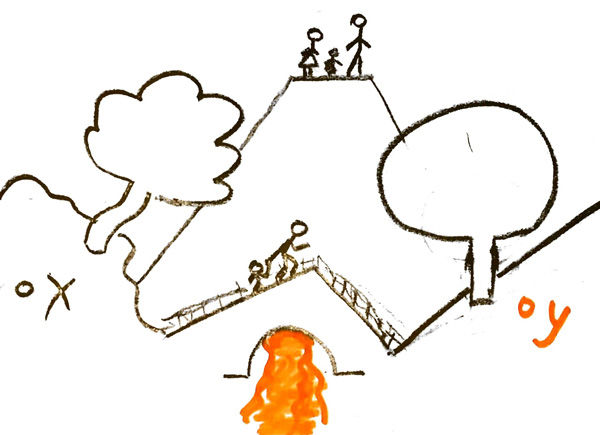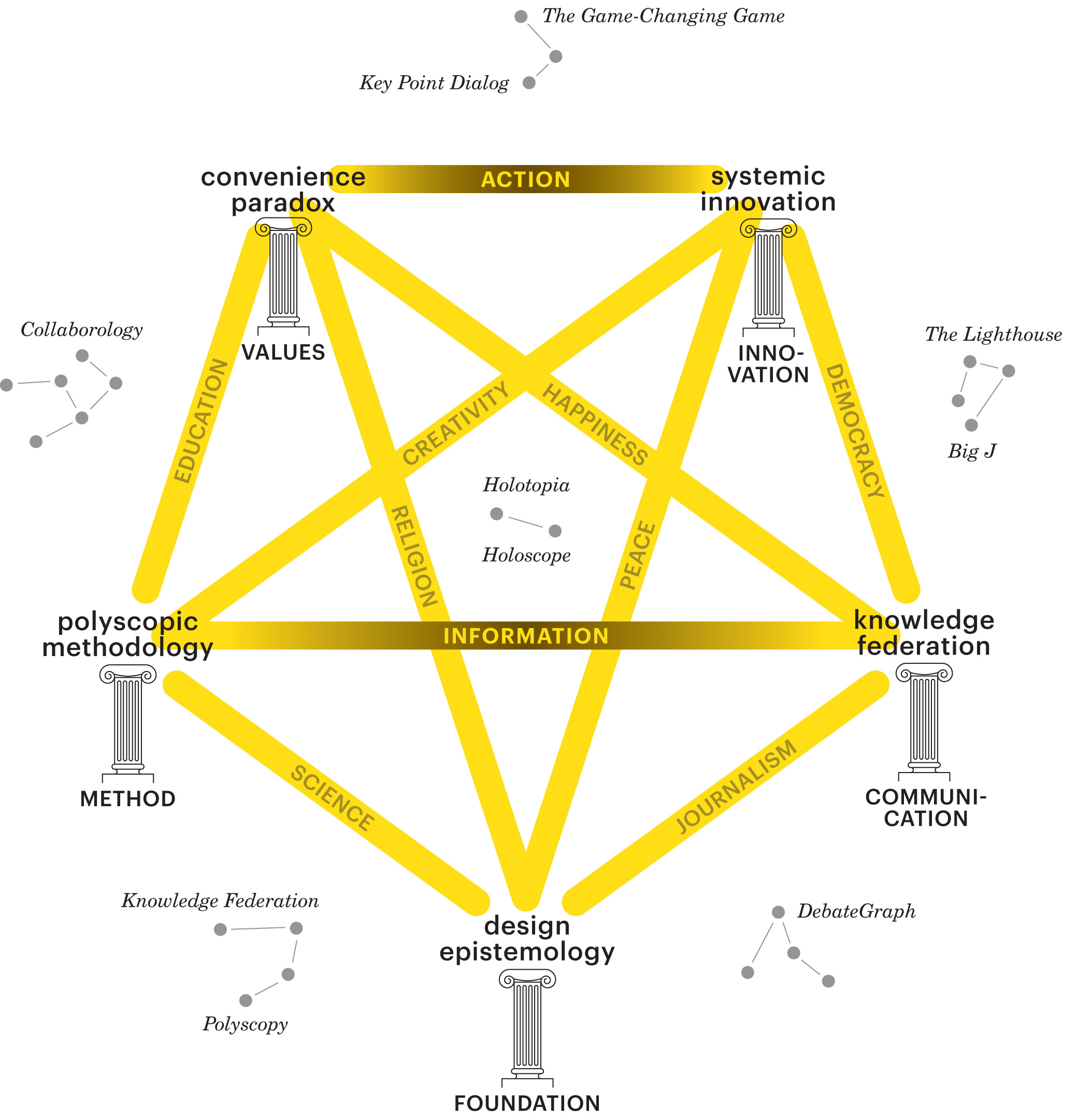Difference between revisions of "N-ideograms"
m |
m |
||
| Line 42: | Line 42: | ||
<div class="col-md-3"><font size="+1">The Knowledge Federation ideogram shows the principle of operation of the 'lightbulb', what makes it work: Instead of <em>reifying</em> our ideas—we create them as a distinct realm; and use them for orientation.</font></div> | <div class="col-md-3"><font size="+1">The Knowledge Federation ideogram shows the principle of operation of the 'lightbulb', what makes it work: Instead of <em>reifying</em> our ideas—we create them as a distinct realm; and use them for orientation.</font></div> | ||
<div class="col-md-7"><h2>Knowledge Federation ideogram</h2> | <div class="col-md-7"><h2>Knowledge Federation ideogram</h2> | ||
| + | |||
| + | <!-- ANCHOR --> | ||
| + | <span id="KF"></span> | ||
| + | |||
| + | |||
| + | <p> [[File:KF-id.jpg]] <br><small><center>Knowledge Federation ideogram</center></small></p> | ||
| + | |||
| + | <p> </p> <p> </p> | ||
<p> The Knowledge Federation ideogram shows two banks of a river joined by a bridge; and there’s a mountain with some stick-figure humans on top in the background. | <p> The Knowledge Federation ideogram shows two banks of a river joined by a bridge; and there’s a mountain with some stick-figure humans on top in the background. | ||
| Line 62: | Line 70: | ||
<p>Vertical abstraction allows us to create simple general insights; like Newton's laws—in all walks of life. By federating what's been found out in various realms.</p> | <p>Vertical abstraction allows us to create simple general insights; like Newton's laws—in all walks of life. By federating what's been found out in various realms.</p> | ||
| − | |||
| − | |||
| − | |||
| − | |||
| − | |||
</div> | </div> | ||
</div> | </div> | ||
| Line 76: | Line 79: | ||
<div class="col-md-7"><h2>Holotopia ideogram</h2> | <div class="col-md-7"><h2>Holotopia ideogram</h2> | ||
| − | |||
<!-- ANCHOR --> | <!-- ANCHOR --> | ||
<span id="Holotopia"></span> | <span id="Holotopia"></span> | ||
| Line 82: | Line 84: | ||
<p> [[File:Holotopia-id.jpg]] <br><small><center>Holotopia ideogram</center></small></p> | <p> [[File:Holotopia-id.jpg]] <br><small><center>Holotopia ideogram</center></small></p> | ||
| − | + | <p> </p> <p> </p> | |
| + | <p>Holotopia ideogram shows the result of it. When the vertical abstraction is applied—when we've federated what we need to know about five pivotal themes (innovation, information, foundation, method and values)—we arrive at five insights that elevate us above the world and allow us to comprehend directions. Each of the five is completely reversed. We can then use the <em><b>five insights</b></em> to contextualize comprehension and handling of various other themes (represented by <em><b>ten themes</b></em>). </p> | ||
</div> | </div> | ||
</div> | </div> | ||
Revision as of 13:21, 20 October 2023
Contents
Ideograms
According to dictionary definitions, ideograms are pictures that represent ideas; but knowledge federation ideograms are a lot more—they stand for communication; for the multimedia techniques that will empower us to communicate the point of it all; condense "one thousand words" to a single point—and make it clear and palatable.
Here I illustrate this technique by three examples; which will also explain—in the language of ideograms—the substance of knowledge federation initiative.
Modernity ideogram
The Modernity ideogram depicts all the keywords mentioned in the keyword section and the related ideas.
The paradigm and paradigm shift; non-sustainability of existing paradigm and what is to be done. Traditional way as inheriting blindly things from the past. No longer traditional—technology enabled society to advance extremely fast. But information and culture still traditional—still inherited from the past! Moment of transition between two paradigms—where we abandoned tradition, but have not yet developed the sensibilities and values and ways of information—to create a functional new way of evolving.
Also the design epistemology — where we see </b></em>information</b></em> as a system within a system; and design it to suit its various functions—notably the function of showing us the way; providing evolutionary guidance.
Knowledge federation is then seen as socio-technical 'lightbulb; created information.
Also illustrates design epistemology and systemic innovation as new fractal; were our task is to self-organize and be new 'headlights'. And in this way become "sustainable".
Knowledge Federation ideogram
The Knowledge Federation ideogram shows two banks of a river joined by a bridge; and there’s a mountain with some stick-figure humans on top in the background. The left bank of the river, drawn as a curvy downward slope with a curvy tree, represents the realm of experience; or what’s called “the real world”. The right bank of the river, drawn as a simplified and abstracted mirror image of the left bank (the river bank is a straight line; the tree is a rectangle with a circle on top) represents the realm of ideas; or what Einstein called “the totality of the concepts and propositions that are laid down in books”. The bridge joining those two banks represents the methodology. The mountain in the background suggests that the realm of ideas needs to be structured as a holarchy (as I explained in Chapter Two); or metaphorically—that information must elevate us above everyday jungleness and help us see things simply and clearly; and that we indeed need both big-picture views (showing ‘lakes and forests’) and detailed views (to help us ‘navigate through the trees’). When we look from the mountain top we see things in proportion; we can then set priorities correctly. The methodology ‘bridge’ makes it possible to take an issue or question—any issue or question from the realm of experience—to the realm of ideas; and theorize it, and comprehend it, and see how it may need to be handled. We can then take the resulting insights back to the practical world—and act in an informed way.
Point — principle of operation is that instead of conflating or reifying; instead of expecting information to "correspond to reality"—we create an independent realm of ideas; notably by using abstraction in suitable ways. Methodology allows us to theorize any theme from real life. Mountain to elevate ourselves above the information jungle; and see things in simple ways. Horizontal abstraction is like creation of keywords—they are ways of looking, simplifications; which allow us to talk about things in experience or "reality" in simple and clear terms.
Vertical abstraction allows us to create simple general insights; like Newton's laws—in all walks of life. By federating what's been found out in various realms.
Holotopia ideogram
Holotopia ideogram shows the result of it. When the vertical abstraction is applied—when we've federated what we need to know about five pivotal themes (innovation, information, foundation, method and values)—we arrive at five insights that elevate us above the world and allow us to comprehend directions. Each of the five is completely reversed. We can then use the five insights to contextualize comprehension and handling of various other themes (represented by ten themes).



